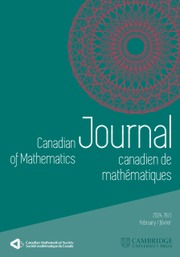Article contents
Sieve-Generated Sequences
Published online by Cambridge University Press: 20 November 2018
Extract
We shall consider a generalization of the sieve process introduced by W. E. Briggs (1) in 1963. Let A (1) be the sequence {ak (1)}, where ak (1) = k + 1, so that A (1) = {2, 3, 4, … }. Suppose inductively that A (1), A (2), … , A (n) has been defined. 4(n+1) will be defined from A(n) = {a1(n) , a2 (n), a3 (n), …} in the following manner: For each integer t ⩾ 0, choose an arbitrary element αt(n) from the set  where an = an(n) , and delete the elements αt(n) from A(n) to form A(n+1). The sequence A is defined to be the sequence {an}. It is also the set-theoretic intersection of all the sequences A(n), n — 1, 2, … . Let
where an = an(n) , and delete the elements αt(n) from A(n) to form A(n+1). The sequence A is defined to be the sequence {an}. It is also the set-theoretic intersection of all the sequences A(n), n — 1, 2, … . Let  be the class of all sequences that can be generated by this sieve process.
be the class of all sequences that can be generated by this sieve process.
Information
- Type
- Research Article
- Information
- Copyright
- Copyright © Canadian Mathematical Society 1966
References
- 7
- Cited by

